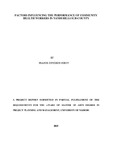| dc.description.abstract | The 2006 World Health Organization report recognized shortages of professional
health workers as one of the key ingredients in the growing crisis of providing health
services, particularly in low income countries. In Kenya, CHWs workforce was
adopted as a component of cost effective strategies in addressing the health care needs
of underserved communities. The implementation of the CHWs concept in Kenya is
marked by unanswered questions of long term sustainability and program
effectiveness. Despite the vast experience with CHWs the burden of disease continues
to increase in magnitude and diversity and relatively little scientific evidence is
available to answer basic questions notably the determinants influencing the
performance of CHW. However both the performance of CHWs as change agents and
the feasibility of implementing and sustaining large-scale CHW programs have been
called into question. The purpose of this study was to investigate the factors
influencing performance of CHWs in Nandi Hills sub-county. The objectives of the
study were to assess the influence of social-cultural, health system practice and policy,
environmental and economic factors on the performance of CHWs in Nandi-Hills subcounty.
A descriptive research design was used. Both quantitative and qualitative data
collection methods were used. Systematic sampling method was used to identify the
respondents. Quantitative data was collected from 87 community health workers of
which 81 responded to the questionnaires, while qualitative data was collected from
community health management team (CHMT), clients (households) and community
health extension workers (CHEWs). Data was presented using tables while inferential
statistics were computed using regression and correlation. Findings showed that
performance of CHWs was low (50-74%). There was strong correlation between
socio-cultural factors (0.884**) and performance of community health workers. The
findings also show that there is a strong correlation (0.799**) between health system
factors and performance of CHWs. Further, the findings show that there is strong
correlation (0.777**) between economic factors and performance of community health
workers. Finally, the findings show that there is a strong correlation (0.775**) between
environmental factors and performance of community health workers. There should be
improved staffing of the facilities where community units are linked in order to
strengthen referrals and linkage systems especially taking into consideration the spatial
distribution and population density. This will improve support supervision from
CHEWs to CHWs during their community work. | en_US |

